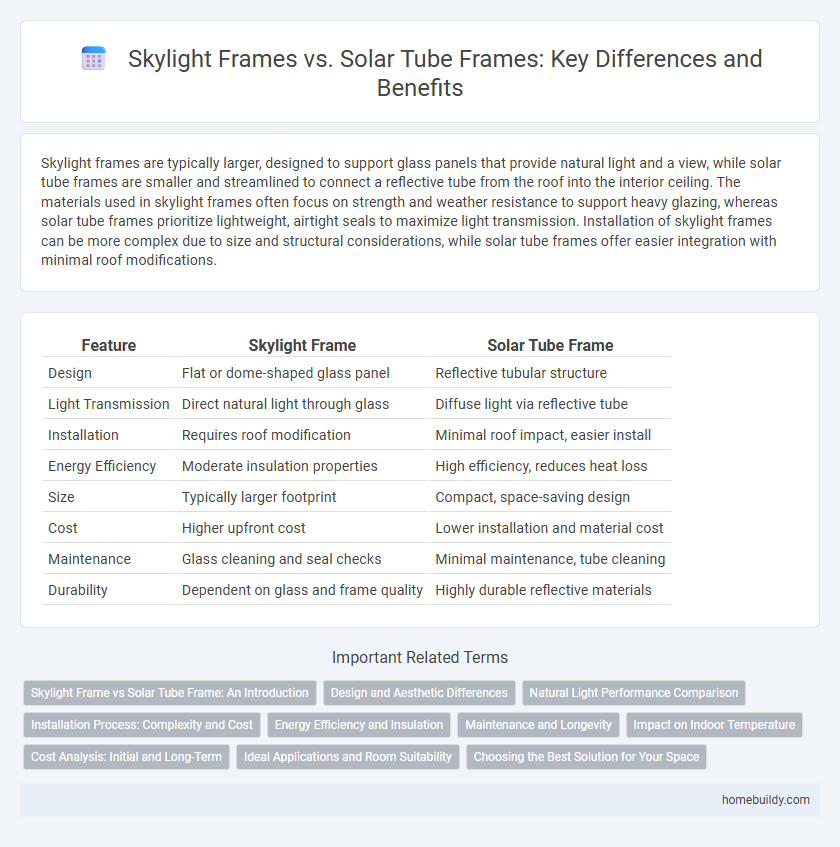Skylight frames are typically larger, designed to support glass panels that provide natural light and a view, while solar tube frames are smaller and streamlined to connect a reflective tube from the roof into the interior ceiling. The materials used in skylight frames often focus on strength and weather resistance to support heavy glazing, whereas solar tube frames prioritize lightweight, airtight seals to maximize light transmission. Installation of skylight frames can be more complex due to size and structural considerations, while solar tube frames offer easier integration with minimal roof modifications.
Table of Comparison
| Feature | Skylight Frame | Solar Tube Frame |
|---|---|---|
| Design | Flat or dome-shaped glass panel | Reflective tubular structure |
| Light Transmission | Direct natural light through glass | Diffuse light via reflective tube |
| Installation | Requires roof modification | Minimal roof impact, easier install |
| Energy Efficiency | Moderate insulation properties | High efficiency, reduces heat loss |
| Size | Typically larger footprint | Compact, space-saving design |
| Cost | Higher upfront cost | Lower installation and material cost |
| Maintenance | Glass cleaning and seal checks | Minimal maintenance, tube cleaning |
| Durability | Dependent on glass and frame quality | Highly durable reflective materials |
Skylight Frame vs Solar Tube Frame: An Introduction
Skylight frames and solar tube frames serve different purposes in natural lighting solutions, with skylight frames typically designed to accommodate large, flat glass panels for expansive daylight entry, while solar tube frames are optimized for narrow, cylindrical tubes that channel sunlight through confined spaces. The structural design of skylight frames emphasizes durability and weather resistance, often featuring robust materials like aluminum or vinyl, whereas solar tube frames prioritize lightweight, reflective components to maximize light transmission. Choosing between a skylight frame and a solar tube frame depends on architectural requirements, ceiling height, and the desired intensity and distribution of natural light within the interior space.
Design and Aesthetic Differences
Skylight frames offer a sleek and minimalistic design that integrates seamlessly with various architectural styles, enhancing natural light without obstructing the view. In contrast, solar tube frames are compact and cylindrical, designed primarily for functional performance rather than aesthetic appeal, often blending discreetly with ceilings but lacking the expansive visual impact of skylights. The skylight frame's glass and metal materials provide a modern, polished look, whereas solar tube frames emphasize practicality with simpler, less visually prominent designs.
Natural Light Performance Comparison
Skylight frames typically offer greater natural light performance compared to solar tube frames due to their larger surface area and direct exposure to the sky, allowing more sunlight to enter interior spaces. Solar tube frames, while efficient in channeling daylight through reflective tubing, often provide less intensity and a narrower light spread, making them ideal for smaller or darker areas. The material and design of the skylight frame, such as aluminum or PVC, also influence light transmission efficiency, with high-quality glazing further enhancing natural light penetration.
Installation Process: Complexity and Cost
Skylight frame installation typically involves cutting through the roof structure, requiring precise measurements, additional framing, and waterproofing steps that increase both complexity and labor costs. Solar tube frames, being smaller and more flexible, usually offer simpler installation with less structural modification and lower expenses. The overall cost difference is influenced by materials, labor intensity, and roof accessibility, making solar tubes a more budget-friendly option for homeowners.
Energy Efficiency and Insulation
Skylight frames offer superior energy efficiency compared to solar tube frames due to their larger surface area and advanced thermal insulation materials that minimize heat transfer. The multi-layer glazing and thermally broken frames in skylights reduce energy loss, enhancing indoor temperature regulation and lowering HVAC costs. Solar tube frames, while effective in natural light diffusion, typically have thinner frames and less insulation, resulting in higher heat gain or loss.
Maintenance and Longevity
Skylight frames typically require less maintenance compared to solar tube frames due to their straightforward design and fewer components exposed to the elements. The durable materials used in skylight frames, such as aluminum or vinyl, resist corrosion and weathering, enhancing longevity over time. In contrast, solar tube frames often involve complex seals and joints that may need more frequent inspections and repairs to maintain optimal performance.
Impact on Indoor Temperature
Skylight frames typically provide better insulation compared to solar tube frames, resulting in more consistent indoor temperatures. The larger glass surface area of skylight frames allows for increased natural light while minimizing heat loss or gain through advanced glazing technology. Solar tube frames, with smaller openings, may cause less heat transfer but often result in less effective temperature regulation due to limited ventilation and light dispersion.
Cost Analysis: Initial and Long-Term
Skylight frames typically have a higher initial installation cost compared to solar tube frames due to more complex materials and larger glass components. Long-term expenses for skylight frames may increase because of potential maintenance, cleaning, and energy efficiency losses, while solar tube frames generally provide lower upkeep and better insulation, reducing energy costs over time. Choosing between the two requires evaluating upfront investment against projected savings in heating, cooling, and durability.
Ideal Applications and Room Suitability
Skylight frames excel in large, open spaces such as living rooms, kitchens, and atriums where natural light enhances the ambiance and energy efficiency. Solar tube frames suit smaller or confined areas like hallways, bathrooms, and closets, providing focused daylight through compact installations. Both frames optimize daylighting but differ in size and structural prominence, influencing their ideal room applications.
Choosing the Best Solution for Your Space
Skylight frames offer expansive natural light and enhance aesthetic appeal, while solar tube frames provide a compact, efficient alternative for smaller or obstructed spaces. Choosing the best solution depends on factors like ceiling height, available roof space, and desired light intensity. Skylight frames suit open areas with high ceilings, whereas solar tube frames excel in tight spaces requiring focused daylight delivery.
Skylight frame vs solar tube frame Infographic

 homebuildy.com
homebuildy.com